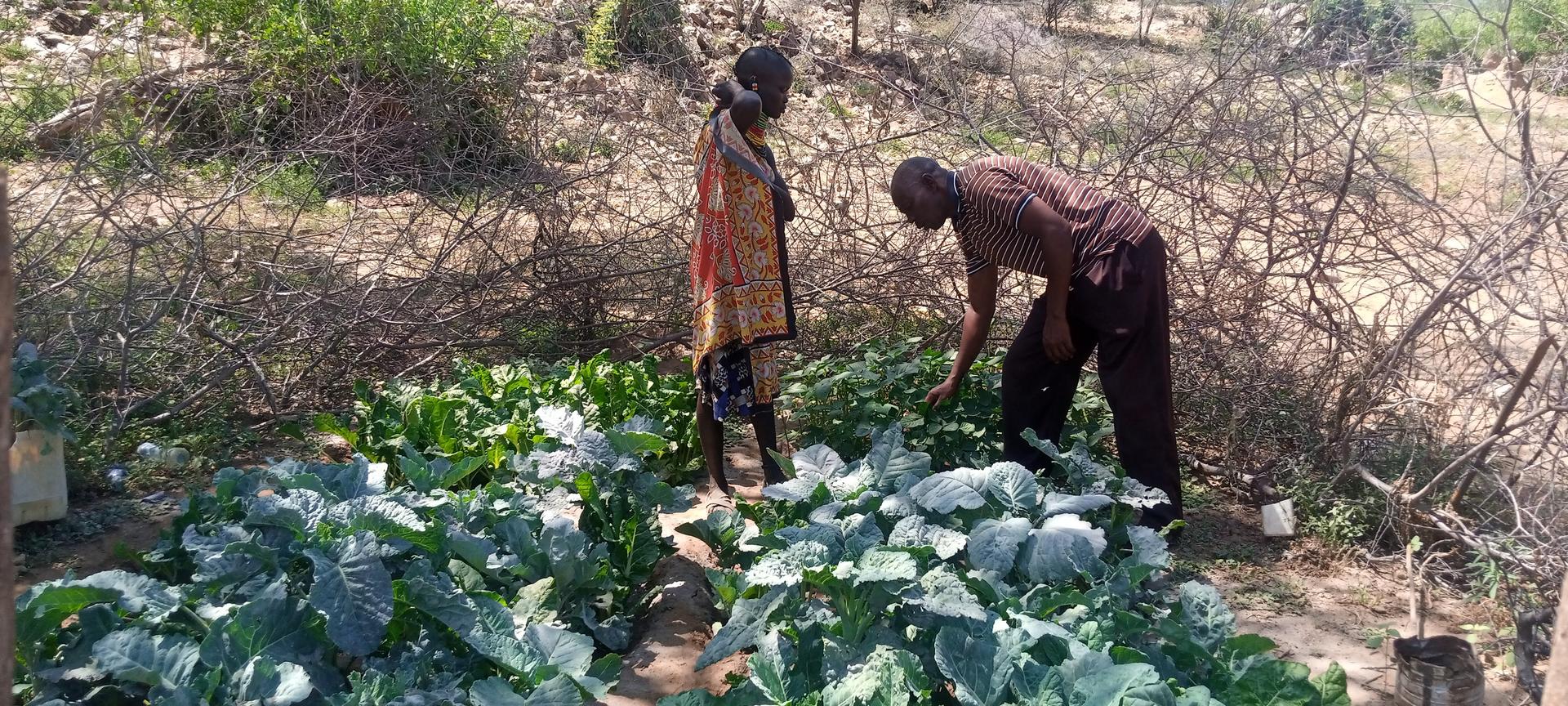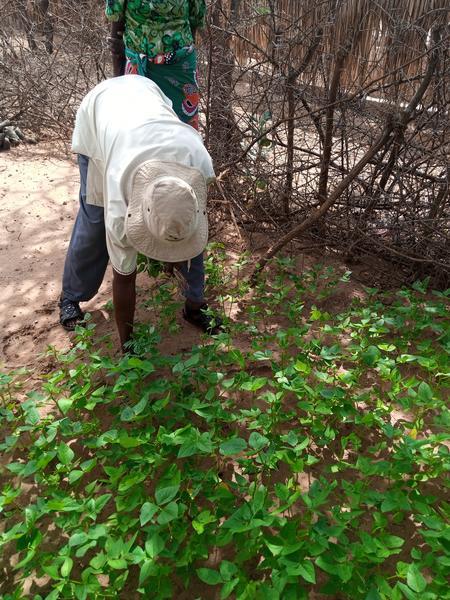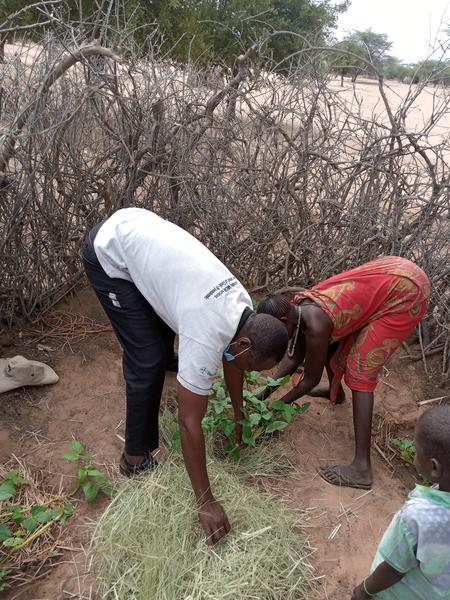Blog How Turkana's communities are cooking up the shift to healthier, more biodiverse diets

By adopting kitchen gardens to diversify diets and livelihoods, a Kenyan community is transforming its agricultural landscape and fortunes.
By: Francis Oduor
The changing landscape can be noticed by anyone, even newcomers. Alice Lolemo, one of the project beneficiaries, explains to us how she now has new neighbors - many newly-built manayattas have brought more life to the once idle village in Atala Kamusio, located some 100 kilometres to the South West of Lodwar town:
“We used to be few households here, just five. But since we started growing vegetables in our kitchen gardens more and more people are migrating here. They have seen that there is something good here. Here they learn how to grow their own vegetables and this saves them a lot of money and time because they don’t have to walk long distances in this scorching sun to go and buy it from Lokiriama. Again, here is near the road and it is easy to get customers for the excess vegetables. You can sell to those people who are passing in this road and get money in return.”
Making the shift to kitchen gardens
Turkana county is one of the 47 counties in Kenya located within the northwestern part of the country and home to approximately 1 million inhabitants. Like other dryland areas, traditional nomadic pastoralism is the main economic activity in the area, which occupies 13% of the country’s total land. With climate change, pastoralism has become an increasingly unsustainable livelihood option, leaving many households in Turkana without access to a daily meal (according to a 2020 survey, only 21% of children and 9% of women consume acceptable minimum diverse diets). Similarly, as nomads become more sedentary, there is an increased need to pursue other livelihood diversification strategies.
Prior to the Participatory Community-led Farm Diversification Project, Alice and other residents in her village depended on pastoralism as their only source of livelihood, supplemented with relief from government and the numerous NGOs that operate in the area. They had never practiced crop farming before. Today, Alice is proud owner of her own kitchen garden growing vegetables in excess of what she needs for her household. She grows lots of spinach, Sukuma wiki and cowpeas in addition to other species of vegetables. The project uses the integrated community-based approach ‒ previously applied in Vihiga County ‒ where communities are empowered to identify their own problems, identify sustainable solutions given community available resources, develop action plans and implement them to improve diet quality through better use of agrobiodiversity. In Turkana County the project is working with ten community groups from Loima and Turkana South sub-counties, where the communities participated in six workshops that culminated in an action plan. All the ten communities sought to implement kitchen gardening as a means to diversify their diets and livelihoods.


Garden demonstrations: thinning vegetables (Lorugummulching), water preservation (Napeikar). Credit: F.Oduor
Before the implementation of the action plans, project partner Save the Children facilitated government extension workers to conduct trainings and demos on kitchen gardening and use of climate smart technologies. To spur utilization of the vegetables produced from the kitchen garden we conducted a nutrition education training for community health volunteers and community health extension workers from all the participating communities who now offer continuous nutrition education and regular cooking demonstrations to their respective communities. The cooking demonstrations are organized by host community with logistical support of the project and the sub-county nutrition coordinators in attendance to give technical backstopping on new recipe preparation and healthy eating guidelines.
Janet Akipetot, the sub-county agricultural officer for Loima sub-county, could not hide her joy during the visit of the ten communities, nearly nine months into implementation of the community action plans:
“I am very surprised with the results, especially of Atala Kamusio. I remember the day we came to conduct training for setting up the vegetable gardens. I was very worried that my efforts would go to waste. It did not seem to me that the participants would ever harvest any crop from the kitchen gardens. But I liked their zeal during the classes. Despite almost none of them having gone to school, they were very active and kept asking questions. None of them had done any kind of crop farming before, other than livestock farming. I feel very proud to be associated with this project.”
Empowering the community
The beauty of the integrated community-based approach lies in the empowerment of the community members to be change agents and to model to others. While only about forty members per community were trained at the start, the number of community members implementing the interventions have now more than doubled. Selina Aipa, one of the beneficiaries from Nawoyaregai village, Lochwaa, tells us how proud she is after being able to successfully guide her neighbors who did not attend the training:
“After the training I came and set up my own kitchen garden. I have also taught five more people and they now don’t have to buy vegetables.”
Janet Akiru from Lorugum community is an indirect beneficiary of the project, having been taught the skill by her neighbor who is a direct project beneficiary. She grows amaranth, spinach, water melon and cowpeas and has recently planted two avocado and orange seedlings. She, like many other farmers, also sells excess produce: “Today I sold cowpeas leaves for Ksh. 120. Sometimes I sell for Ksh. 50 and sometimes upto Ksh. 200 and use the money to buy other things I do not have here like maize flour, tomatoes, onions and soap.”

Demonstrating proper harvesting of cowpeas leaves in Namoruputh. Credit: F.Oduor
Assessing long-term impact
The project, which is nearing completion, seeks to institutionalize the good practices of the community-based approach applied in Vihiga County and document lessons for scaling. Thus, although there are clear signs that the impact of the project will be felt many years after it comes to an end, after 12 months of implementation of the plans, a final impact evaluation will be carried out to establish the impact of the project and assess the factors that facilitated any observed changes or lack thereof.
“From my observations and the feedback from the community there are a lot of positive things compared to other projects which shows that the community have owned the project and will continue with it. We will however, still need to continue monitoring the project and offering induction trainings especially for those who did not directly benefit from our training and are now implementing. Again, there are areas that are very remote and may not easily access the required inputs. For these we can continue supporting them with seeds and advice.”
stated Francis Emuto, the sub-county agricultural officer for Turkana South. And it is true that, while the sourcing of seeds was initially a challenge, it is no longer a problem since the county government recognized the need and regularly distributes seeds to farmers. During our visit, we distributed cowpea, spinach, kale, and watermelon seeds to farmers, given by the county government.

A vegetable garden in Atala Kamusio. Credit: F.Oduor
But the project is not without challenges. The main challenge cutting across all the communities and farmers is the lack of access to adequate water for watering the crops. Most of the farmers source their water from very distant places ‒ more than five kilometers in some cases ‒ and in other cases, the farmers must purchase water for their use because the water pump was faulty. This may discourage some of them.
In addition, though the community was trained on pest and disease management and the majority were already practicing the various methods, pests and livestock invasion still remained a major challenge. We noted poor harvesting technique of the vegetables, which reduced the productivity lifespan of the vegetables, and other poor agronomic practices related to inadequate spacing of the vegetables in the garden and inadequate watering techniques. During our last visit, appropriate practices were demonstrated and farmers were advised accordingly.

The community action plans are being implemented through collaboration with Save the Children and the county government of Turkana. It is being carried out with financial support from the German Federal Ministry for Economic Cooperation and Development (BMZ) through the Deutsche Gesellschaft für Internationale Zusammenarbeit (GIZ) and the Fund for International Agricultural Research (FIA). It is also supported by the CGIAR Research Program A4NH.
